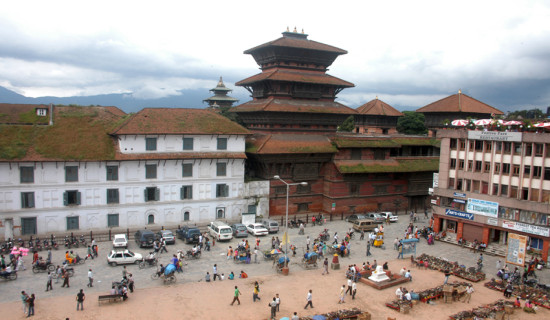- Saturday, 27 December 2025
Monsoon's Warning Wrath
The season of monsoon brings life-giving water to parched fields, giving new lease of life to dying crops as well as newly planted ones. In the fields lacking irrigation facilities, it is nothing short of a godsend for farmers. When it fails to arrive, agriculture output, and to a great extent GDP, nosedives, threatening food security and putting millions of lives in jeopardy. But it is also associated with devastation. Barely a week after the full-fledged monsoon made its way into Nepal, the country is reeling from the disasters brought by it.
At least 14 persons lost their lives, eight were injured and two others have gone missing in monsoon-induced natural calamities like landslides, lightning strike and floods in different parts of the country on Wednesday alone. According to the National Disaster Risk Reduction and Management Authority (NDRRMA), of the total fatalities, eight died in landslides with five left injured and five others died in lightning and one in flood. Five died in landslides in Lamjung, two in Kaski and one n Okhaldhunga. Similarly, lightning claimed five lives across the country, of whom two died in Jhapa, one in Sunsari, two in Sunchhahari Rural Municipality-3 in Rolpa, where one more died due to flooding.
Incessant rainfall has caused flooding in various areas across the Tarai region, flooding much of Sunsari district and Birtnagar. In Sunsari, three days of continuous rains have resulted in inundation in rural wards of Inaruwa and Duhabi municipalities, with some wards lying submerged in three feet of flood water. What's more, the flooded rivers have entered the settlements there, displacing hundreds of people. A big chunk of arable land has also been washed away. Likewise, massive flooding in Biratnagar, Morang, turned the industrial city into a scene of chaos, disrupting daily life of its inhabitants.
In Nepal, and to a great extent, South Asia, climate change is said to have made the monsoon more erratic, dangerous and less dependable, with more violent downpours as well as worsening dry spells. Basic science explains this phenomena: Warmer air absorbs more moisture, which gets accumulated in the atmosphere and stays there longer due to its lightness compared with colder air, prolonging dry spells. But, once it rains, all of that moisture is dumped within a short time, resulting in a month's or week's rainfall in a few hours or in a few days. This is how flash floods happen. Last year's devastating flood in Kagbeni of Mustang district, bore the hallmark of a flash flood, and the scientists attributed it to climate change.
As the monsoon has just begun, in all likelihood, these are the only the glimpses of what also might come in much more intensity and ferocity. This probable catastrophe must jolt the relevant agencies working for disaster management as well as everyone vulnerable out of their complacency. The authority has estimated that 1.8 million people and 412,000 households will be affected by this year’s monsoon rains. Some 83,000 households will be directly affected, and 18,000 families may have to be rescued in monsoon-related disasters.
Weeks before its entry, the government had made public its monsoon preparedness and rescue plan, which was claimed to be well thought-out. But the Wednesday's ravages have left us wondering why it fell short in preventing them. As the monsoon progresses in full force, all relevant agencies have no time to waste to mount matching response so that many lives and properties could be kept safe from wrath of monsoon.

















